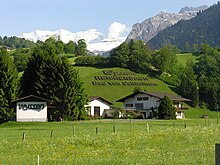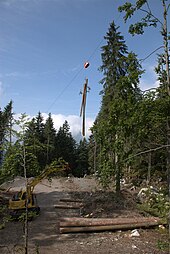Wyssen cable cars
| Wyssen Seilbahnen AG | |
|---|---|
| legal form | Corporation |
| founding | 1926 , AG since 1977 |
| Seat |
Reichenbach in Kandertal Switzerland |
| management | Jakob M. Wyssen |
| Number of employees | 37 (2011) |
| Website | www.wyssen.com |
The Wyssen Seilbahnen AG is a provider of mechanical engineering Swiss industrial company in Reichenbach . The legal form of the company has been a stock corporation since 1977 , with the share capital being owned by the Wyssen family. The company was founded in 1926 by Jakob Wyssen. The company operates internationally and generates around 40% of sales abroad.
The company became known in 1939 through the production and sale of the first forestry rope crane and the subsequent modeled devices.
history
The company was founded in 1926 by Jakob Wyssen (1904–2003). In 1938 the first cable crane with a carriage and adjusting device to guide wood was produced. After Jakob Wyssen had worked in Canada for a few years in 1950, the carriages for woodworking became known there too. For Wyssen Seilbahnen AG, until around 15 to 20 years ago, most of the main productions were traditional forestry. Customers are forestry companies, cable car transport companies, construction companies, mountain railway companies and commercial or private mountain hut owners.
Developments and patents
In 1939 Jakob Wyssen developed the cable crane with a trolley (carriage) because of the technical uselessness of the cable car in plenter forest management : Here - temporarily - permanently installed systems for cable delivery , such as those set up in large-scale clear - cutting , cannot be used sensibly. The Wyssen crane soon became standard equipment, especially in extreme alpine forestry, which was not replaced by further developments until the 1960s ( e.g. the tilting mast cable crane / Gössen crane ).
Since the ropes are playing an increasingly important role again in modern, more sustainable forestry, there has recently been another development boost. Important patents from recent years are:
- 2005: Rope crane, inventor: Jürg Wyssen
- 2007: “Charge dropper for use with an avalanche blasting track or ...”, inventors: Jürg Wyssen and Samuel Wyssen
- 2008: Chorkerring, inventor: Jürg Wyssen
- 2009: Self-propelled cable car, inventor: Jakob Wyssen
Products
Standard products submarkets:
- Cable winches serve as a pulling or braking machine to move the wagon of the cable crane or cable car. They are offered in 8 different sizes with pulling forces between 1,500 and 15,000 kg. Each size is available with a diesel or electric motor and with a mechanical or hydraulic drive. At least five different versions are offered for each size, depending on requirements.
- Carriages are transported on the carrying cable with the help of the pull cable through the cable winch. The load to be transported is in principle attached to the carriage and transported along the rope line. Carriages are available in 4 different sizes, for payload ranges between 2.5 and 10 tons, in mechanical or hydraulic design. Various designs for gravitational or rotary drives are available. Carriages are mainly used in forestry.
- In contrast to the carriage, motorized rope cranes are equipped with their own motor to move the hoist rope, which is wound on a drum on the carriage. The standard version is transported with a winch. A special version can move on flat terrain with its own motor. Motorized rope cranes are mainly used on construction sites due to their special transport capabilities, such as driving with a lowered load.
- A cable car is a self-propelled device for smaller loads in sizes for 200 or 400 kg payload. The drive with motor is located on the carriage, which can move independently on the suspension rope. This type of cable car is a fairly inexpensive and simple installation for accessing remote mountain huts, guest houses or dairy huts.
- Accessories for the assembly, maintenance and operation of cable cars such as B. cable tensioning devices, cable car masts, suspension cable saddles for masts, cable clamps, safety belts for climbing masts, pulleys, etc. do not take an insignificant position. Some products in the accessories division are not manufactured in-house and are sold as commercial goods.
In particular, the company (branch wyssen avalanche control , wac) has a reputation as a specialist manufacturer of cable cars and also for avalanche detonators for the automatic release of avalanches by blasting them . These cable cars, which transport the avalanche explosives to defined detonation points of known avalanche stretches, are considered safer than, for example, personal access , shelling or dropping from a helicopter . An even more modern solution are firmly anchored towers. They are becoming more and more important in securing slopes in ski areas, and are also increasingly being used to secure traffic routes. Such systems can now be found in most of Austria's large ski areas (represented by Wyssen Austria GmbH Innsbruck- Hötting ), so around 2010 there were 57 of the company's systems in Ischgl- Samnaun alone (27 towers in the community, 17 in the Samnaun ski area, 3 in the Ischgl ski area). This method was also used in avalanche research.
In 2012 an extension was completed, a 1000 m², 80 meter long and 1.5 million Swiss franc expensive hall. It serves the expansion of Wyssen Avalanche Control AG, which deals with the production and sale of the explosive masts.
Web links
Individual evidence
- ↑ Entry in the commercial register ( Memento from January 16, 2013 in the web archive archive.today )
- ↑ a b c Wyssen Seilbahnen AG - company portrait
- ↑ a b c http://www.bernerzeitung.ch/region/thun/Die-Firma-Wyssen-baut-eine-neue-Halle/story/12552368
- ↑ http://www.jungfrauzeitung.ch/artikel/114874/
- ↑ see Slovenian Forestry Institute: Questionnaire evaluation on the state of education and training methods in timber harvesting using a cable crane in selected EU countries ( Memento from February 21, 2014 in the Internet Archive ) . Status Quo Analysis , Part 2, Ljubljana, January 2012, Table 5: Introduction and development of rope technology in the country: First forest rope crane in 1939 , p. 13 (quoted by Karl Stampfer, Boku Vienna) PDF, athosk.eu
- ↑ Swiss Federal Institute for Intellectual Property (PDF; 1.6 MB), accessed on September 1, 2012
- ↑ Swiss Federal Institute for Intellectual Property (PDF; 1.4 MB), accessed on September 1, 2012
- ↑ Patente.DE , accessed on September 1, 2012
- ↑ Self-propelled cable car "saves the rope" (registration October 17, 2002) , accessed on September 1, 2012
- ↑ Patent.DE , accessed on September 1, 2012
- ↑ Federal Institute for Intellectual Property , accessed on September 1, 2012
- ↑ wyssen avalanche control , wyssen.com/wac
- ↑ a b c Artificial avalanche release, presentation for a lecture by Samuel Wyssen, Hofburg Talks 2010 (pdf, Federal Ministry of Economics - bfw.ac.at; 11.0 MB)
- ↑ http://www.derbund.ch/zeitungen/bernseite/Wenn-Lawinen-absichtlich-ausgeloest-haben/story/17285982
- ^ Reference list of references ( Memento from January 14, 2013 in the web archive archive.today ) , alpintechnik.at
- ^ Company Wyssen Austria GmbH . Commercial register data Creditreform / firmenabc.at
- ^ For example: Samuel Wyssen: 10 years of experience with the Wyssen avalanche tower . In: Jürg Schweizer, Alec van Herwijnen, WSL Institute for Snow and AvalancheResearch SLF, Swiss Federal Institute for Forest, Snowand Landscape Research WSL (ed.): International SnowScience Workshop , 27 September - 2 October 2009, Davos, Switzerland, Proceedings, p 597
- ↑ Company data , accessed on September 1, 2012
- ↑ Explosive masts instead of protective structures? , accessed September 1, 2012

